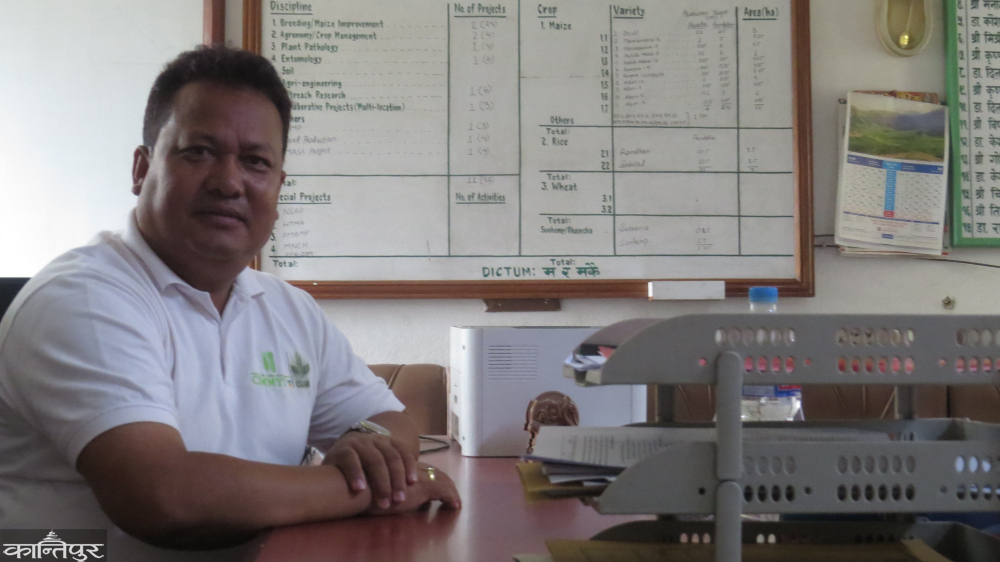
We use Google Cloud Translation Services. Google requires we provide the following disclaimer relating to use of this service:
This service may contain translations powered by Google. Google disclaims all warranties related to the translations, expressed or implied, including any warranties of accuracy, reliability, and any implied warranties of merchantability, fitness for a particular purpose, and noninfringement.

Highlights
- During his 27 years of employment, Rajendra has developed 15 varieties of Kosebali, he has developed 5 varieties in Mussoo, 3 in Moong, 2/2 in Soybean and Maas and 1/1 in Rahar, Rajma and Bodi.



Cultivation of food crops containing 'protein', which is considered as a guard for human organs, is essential for the soil. Rajendra Darai, who is involved in pulse research, says that pulse cultivation is like creating a 'mini nitrogen factory' for the soil. Its roots build up soil nutrients.

He said that if pulses are planted properly, the urea fertilizer that needs to be imported and spread on the fields can be reduced by up to 35 percent. Darai is the Chief Scientist of the National Agricultural Research Council (NARC). According to the census of 2078, the population of the tribal Darai community, which belongs to the marginalized category, is 18,695. However, the leaders of this community say that the population is slightly higher. The Darai are tribals of the plains of Chitwan. The population of Darai in Chitwan is 8 thousand 850.
Rajendra Darai's house is in Bharatpur Metropolitan City-15 Mangalpur. The population of Darai within the metropolis is 3 thousand 413. Rajendra, who belongs to the Darai community, which is considered a minority in terms of population, started his journey to become the chief scientist of NARK on October 15, 2053. He started his working life as a technical officer of Narc after passing the civil service examination. Before that he was working in an NGO. It is easy for those who have studied agriculture to get a job in various 'projects' within the country or abroad. But he decided to join the government service. "Government service may/may not be personally beneficial, but I felt that I can contribute to agriculture by going to a place like NARK and came here," said Rajendra.
Darai has not even made up his mind to go to Agricultural Development Bank and Agricultural Services Department. He tried to get a job once in the Agricultural Development Bank and twice under the Agricultural Services Department but was unsuccessful. After that, he got serious and started preparing for public service. After thinking about it, I decided to go into the research field. After succeeding in the first exam for Narc, he started his career with enthusiasm. "My name was number two among those who were successful in the interview," he said. He came from open competition at that time.
In Mangalpur there is a slum of Darais. Tanahun is the father of Dharamsingh Rajendra's grandfather of Sewar village in Damauli Aad. Dharamsingh migrated from Tanahun to Nawalparasi Gandakot. Then he entered Chitwan and settled in Lanku near Narayangadh. From Lanka reached Gaurigunj in Bharatpur. Kachapche, then a village in the north-west, came from Gauriganj. Rajendra's ancestors did not stay for long even in Kachpache, now known as Yajnapuri. Then they came to Mangalpur and stayed there.
 The traditional occupation of the Darai community was agriculture. Choosing an area suitable for agriculture and livestock, Rajendra's ancestors came from Tanahun to Mangalpur. Coincidentally, Rajendra also chose agriculture as the subject of his higher education and also chose agriculture as his job field. V.No. Born in Mangalpur on July 15, 2028, Rajendra passed SLC in 2044. Near home was the famous Rampur Campus for agricultural education in Rampur. After SLC, he took admission in ISC with agriculture subject. After that, he did his graduation (B.Sc. Ag) in agriculture. At that time, three years of study was enough for a bachelor's degree. After graduation from Rampur, he went to India to pursue post graduation (MSc Ag).
The traditional occupation of the Darai community was agriculture. Choosing an area suitable for agriculture and livestock, Rajendra's ancestors came from Tanahun to Mangalpur. Coincidentally, Rajendra also chose agriculture as the subject of his higher education and also chose agriculture as his job field. V.No. Born in Mangalpur on July 15, 2028, Rajendra passed SLC in 2044. Near home was the famous Rampur Campus for agricultural education in Rampur. After SLC, he took admission in ISC with agriculture subject. After that, he did his graduation (B.Sc. Ag) in agriculture. At that time, three years of study was enough for a bachelor's degree. After graduation from Rampur, he went to India to pursue post graduation (MSc Ag).
He completed his MSc in Agriculture from Chandrasekhar Azad Agricultural University, Kanpur, India. Then four years ago, he also did Vidyavaridhi (PhD). He received his PhD from the University of Agriculture and Forestry in Rampur. Though traditional occupation was agriculture, Rajendra's family had an educational environment. Rajendra's father, Buddhiram Darai, is a retired high school teacher. "After my father became a teacher, it became a good environment for studying at home," said Rajendra. Rajendra says that the inspiration of his mother Vimala Darai, who is active in the social sector, motivated him to move forward.
I got the courage to study because of my father. Where we are today, our mother also has a big hand in it," said Rajendra. Rajendra said that mother Vimala inspired her children to stand on their own feet. You have to make your own identity through your own efforts. No one else will do anything for you. That's why my mother emphasized from a young age that you should work hard, be disciplined, pay attention to your studies," said Rajendra. Rajendra says that he came here with this guidance of his parents.
Rajendra reached Itahari at the beginning of his working life. After 21 months, Kosebali came as a research technician under NARC in Rampur. By coming here, he understood the importance and need of dal and kosebali.
He said that there are 20 types of rice crops of different varieties that are used for pulses in Nepal. Among them, 11 crops are cultivated more in Nepal. Most of the lentil crops are being harvested. "Lentil crops account for 60 percent of the dal crops in Nepal," said Rajendra. Rajendra did his PhD on this lentil. His study developed two varieties by making Khajura Lentil-4 and Shraddha Black Lentil. "These are lentil varieties that are tasty, climate friendly, disease tolerant and nutritious," said Rajendra. He said that these new breeds were developed by selecting from local breeds.
21 years after starting his working life, he transferred from Rampur to Banke Khajura and became the head of the National Cosebali Research Office. He said that he was able to do a lot of work on pulse cultivation because he spent a long time of his working life in rice research and breed development. In 27 years of working life, he has developed 15 varieties of kosebali. "I have developed five varieties of lentil, two of soybean, three of moong, two of masa, one each of rahar, rajma and bodi," said Rajendra. Nepalese lentils are the best in South Asia. It is high in nutrients like protein, iron and zinc. Sweet to eat, small seeds ripen quickly. And, the crop that farmers do not spray is also lentils. There is a huge demand for it in the international market," said Rajendra.
Earlier there was a good export, but now it has stopped, he appealed to the government to encourage farmers to farm and create an environment for export. Adivasi Sumdaya, who are still few in number, have very little access to government jobs and other positions of public recognition, from education. But Rajendra Darai remained apart from it. Other brothers and sisters in Rajendra's family are also ahead in the field of education. He said that the family environment helped him to move forward. But this is not the case for everyone.
Many of the tribal minority communities find it difficult to move forward. The government should help them. For this, attention should be paid to education. I suggest that it is better to create a good educational fund," said Rajendra. He says that there is still a tradition of disbelief when people say that they are the children of tribals. It is customary to evaluate our community by looking at what Darai can do. But after listening to my work and my arguments, they are watching," said Rajendra.
He has been sharing his knowledge and experience by reaching abroad. He recently went to Belgium and shared his experiences with participants from 19 countries. "Although evaluation is done on the basis of ability and quality of work abroad, it seems that such a practice has not yet increased in Nepali society," said Rajendra. Rajendra, who has been the head of Kosebali since 2074, is now the head of National Maize Crop Research Program of NARC in Rampur, Chitwan. He has come to this office since November 1 of last year.
Chief Scientist Darai's focus is now on the maize crop. He said that he is interested in the development of baby corn, sweet corn and pop corn, which are considered good in terms of price. There is a low budget for agricultural research in the country. However, we are engaged in research. He was inspired to read at an early age. When I grew up, I made up my mind to contribute something different and when I grew up in that responsibility, challenges came, but I am moving forward," said Rajendra.
 प्रकाशित : श्रावण ७, २०८१ १०:२३
प्रकाशित : श्रावण ७, २०८१ १०:२३

 २२.१२°C काठमाडौं
२२.१२°C काठमाडौं











